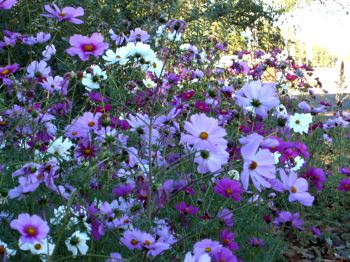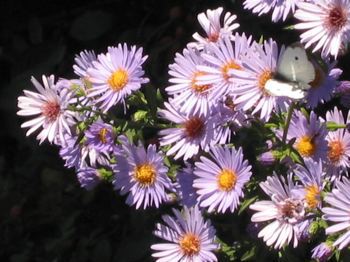Sizing up the Summer Garden
From the Davis Enterprise, October 26, 2006
October is winding down, and the weather finally feels like fall in the Sacramento Valley. It's time to plant cool-season vegetables and flowers. Broccoli, cauliflower, cabbage, lettuce, and greens. Peas, radishes, parsnips, and turnips. Pansies and violas, snapdragons, calendulas, and many more.
But an important part of planning your garden next year is noting how things did this year.
So to that end, here are the "awards" from our summer garden 2006!
Most productive
Juliet tomato. Hundreds of shiny red little pear-shaped tomatoes, which drop neatly into your hand with just a gentle pull. Every fruit usable: excellent for salsa, easy to peel (freeze them first). This was the star of the tomato patch this year: great quantities, very useful.
 A bowl full of Juliet hybrid tomatoes awaits processing. For salsa, soup, or sauce, this was a very productive plant this summer.
A bowl full of Juliet hybrid tomatoes awaits processing. For salsa, soup, or sauce, this was a very productive plant this summer.
Most prolific
Currant tomato. Thousands of tiny red fruit, far too many to eat, and this one is strictly for fresh eating. SunGold hybrid, a golden cherry tomato with great flavor, is first runner-up in this category. Always a taste-test winner, and very heavy yields.
Least productive
Brandywine. Sorry, heirloom tomato lovers, but this most-popular heirloom was a dud again. My six foot vine, perfectly healthy, produced four (4!) fruit. They took forever to ripen, and one of them rotted just as it did. I can't really recommend this old favorite for the Sacramento Valley.
For an excellent alternative heirloom variety, Giant Belgium produced about 25 fruit, nearly two lbs. each, dark pink, very meaty, and excellent flavor. One of the few beefsteak types I've had good results with.
 Cosmos as far as the eye can see? A couple of ounces of Sensation Cosmos seed planted in May produced a spectacular late-summer border. Cosmos love full sun, but can tolerate a little shade. They are likely to reseed.
Cosmos as far as the eye can see? A couple of ounces of Sensation Cosmos seed planted in May produced a spectacular late-summer border. Cosmos love full sun, but can tolerate a little shade. They are likely to reseed.
 Cosmos close up, with sunlight shining through the petals. The Sensation variety comes in shades of pink, red, and white.
Cosmos close up, with sunlight shining through the petals. The Sensation variety comes in shades of pink, red, and white.
Most interesting
Pineapple, an oddly named heirloom tomato. The thin-skinned yellow-gold fruit is suffused with red striations. "Sweet, refreshing, with a hint of fruit," says an employee. It was a good producer. Husky Gold, a yellow-fruited hybrid, did out-yield it, but had smaller fruit with tougher skin.
Prettiest pepper
This was a tie. Blue Jay, a lilac-colored bell pepper, had the most decorative fruit. Also very tasty, thin-walled, and productive. But Thai Dragon, a super-hot pepper, was the most attractive plant. This tight little shrublet with dense foliage bristled with narrow, bright red, fiery-hot peppers (probably the second-hottest pepper around). Worth growing as an ornamental, even if you don't use hot peppers.
Most over-planted
Habaņero pepper. My boys thought planting six of these would be no problem. Ok, each plant produces about 30 - 40 of the hottest peppers in the world. Recipes, anyone?!
Best bang for the buck
The ounce of State Fair Zinnia seed I scattered along the path in the vegetable garden. At about $5, it grew into a 20' border of 4' tall plants producing armloads of flowers all summer. A pack of Zinnia seeds planted in May will hook any kid on gardening. Big bold flowers in neon colors, and each one lasts for days.
A close second would be the 2 ounces of Sensation Cosmos I planted along the county road. About 40' of pink, red, and white blossoms, since August and ongoing.
 The Fence aster is named for the habit of the flower stems. Long and sprawling, they can poke up through fences and hedges, then burst forth with lavender blooms in late summer and fall. All asters are very attractive to butterflies.
The Fence aster is named for the habit of the flower stems. Long and sprawling, they can poke up through fences and hedges, then burst forth with lavender blooms in late summer and fall. All asters are very attractive to butterflies.
Most disappointing
The family orchard. With over three dozen trees, you'd expect us to be awash in fruit. But with seven weeks of rain through the bloom period we got practically nothing: peaches, nectarines, plums, pluots, apricots-all a washout.
It wasn't a total loss: the berry vines (the intentional ones) yielded great. We've got hundreds of Fuyu persimmons coming on, and a couple of dozen pomegranates. After eight years, the acre of pecans we planted is producing its first major crop.
Most accomplished
Clearing out a 40' stretch of overgrown wild roses and berries. With a couple of teenage boys and a few machetes (and some nitrile coated gloves), it's amazing how much mayhem you can accomplish. They're faster than goats and almost as easy to feed. 100+ berry plants dug out and still counting. A whole new area to plant!
Nicest place to sit in 100 degree weather
The bamboo grove my father planted 15 years ago. Surrounded on all sides by dense clump-forming bamboo, in the shade of a row of Dawn redwoods (Metasequoia), even 110°F didn't seem so bad. I've added some banana plants in recent years, and one of these days we'll actually line and fill the pond we dug. In 2004.
Most attractive to wildlife.
For a long time this award would have gone to a thicket created by suckers of some old plum rootstock, which has provided cover and habitat for quail, pheasants, and other birds. Or perhaps the overgrown Rosa banksia, which is always active with songbirds.
But a few years ago I planted a meadow, about half an acre, with a type of narrow-bladed fescue grass and this year we allowed it to grow very long. Nearby wild roses have formed a couple of thickets. So this summer a pair of red foxes took up residence, and nearly every evening can be seen playing in the tall grass. Cute mammals trump birds every time.
A close runner up, or perhaps the award for "most attractive single plant," goes to Aster caroliniana, the Fence aster (the long, lanky flower spikes climb up through fences and hedges). A plant we'd put in years ago was buried under all those berries and roses (see above). Suddenly in sunlight again, it's climbed up into nearby roses and has been blooming for several weeks. I have never seen a flower more attractive to butterflies.

Best new modern rose
Marilyn Monroe, a buff-colored hybrid tea introduced in 2003, continues to really impress me. Large, elegant flowers range from nearly white in hot weather to creamy apricot in cool weather. Each flower lasts for days, and the plant hardly showed any disease in this soggy spring. This one is going to be a keeper. But there are a lot of close runners up: Sunset Celebration, an amber-pink blend Hybrid Tea. Memorial Day is a clear pink Hybrid Tea with great fragrance. Fourth of July is a red-and-white striped climber that blooms nonstop.
Now it's time to pull out the summer vegetables and flowers, time for more plantings of winter vegetables and flowers. It's great weather for digging up perennials and dividing them, to give away or spread around. We'll plant seeds of clover, fava beans, and vetch in the areas where we won't be having vegetables, and add some more grass seed to expand the meadow. Wildflower seeds and bulbs will be going into the further reaches of the property. And somehow I made room for a few more roses to be planted this winter.
How did your garden grow this year?
© 2008 Don Shor, Redwood Barn Nursery, Inc., 1607 Fifth Street, Davis, Ca 95616
www.redwoodbarn.com
Feel free to copy and distribute this article with attribution to this author.
Click here for Don's other Davis Enterprise articles
